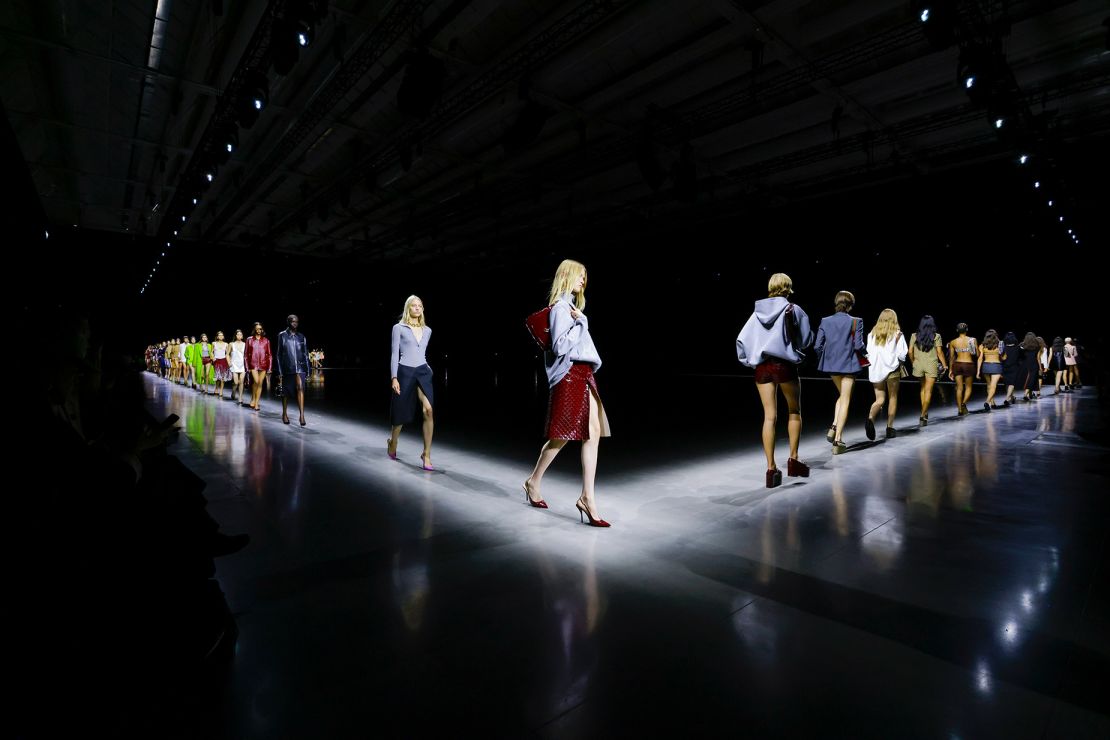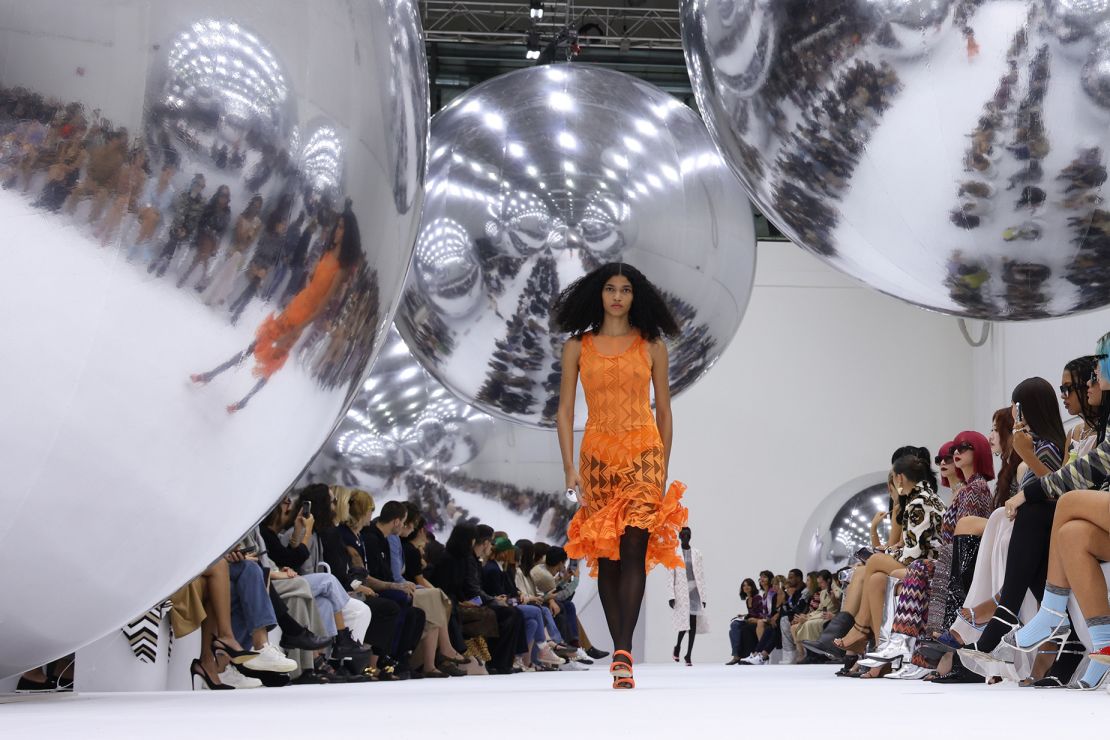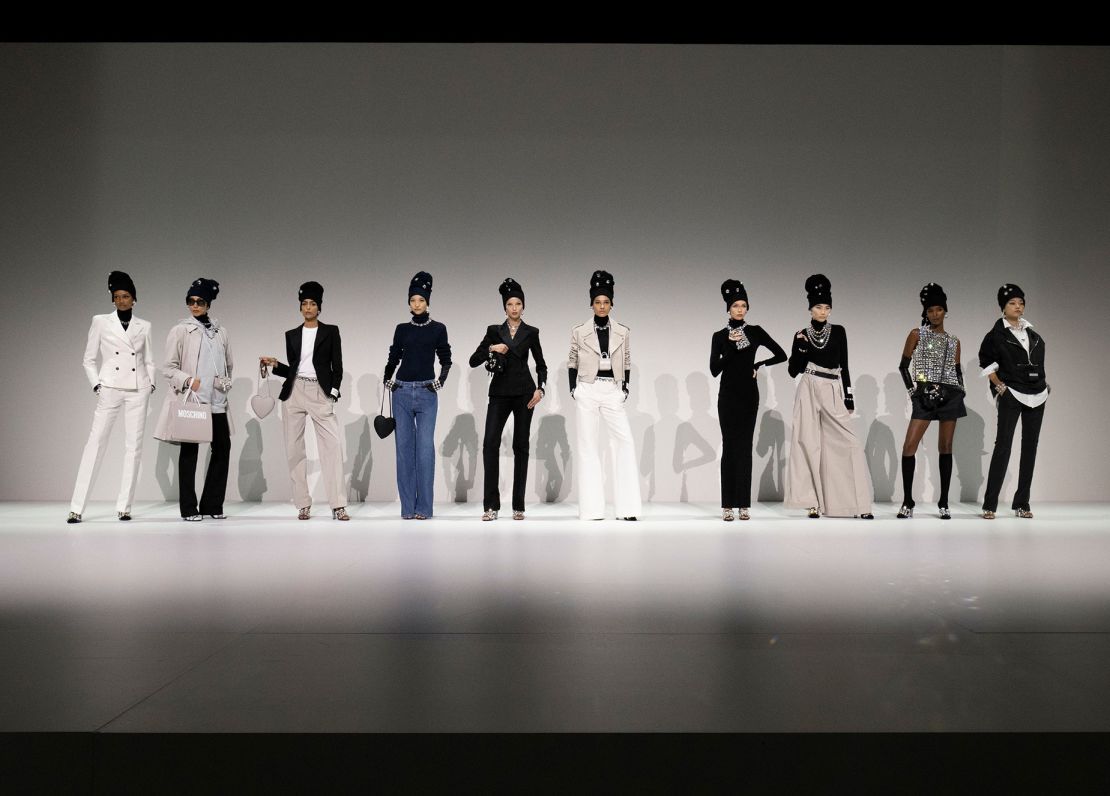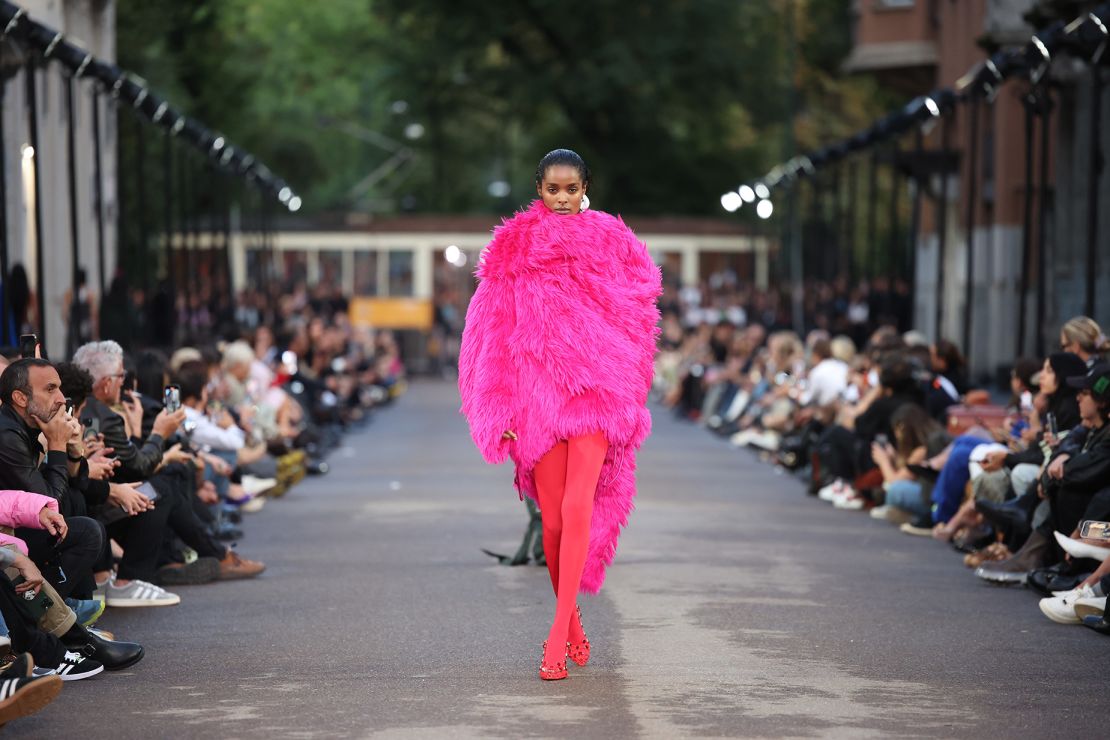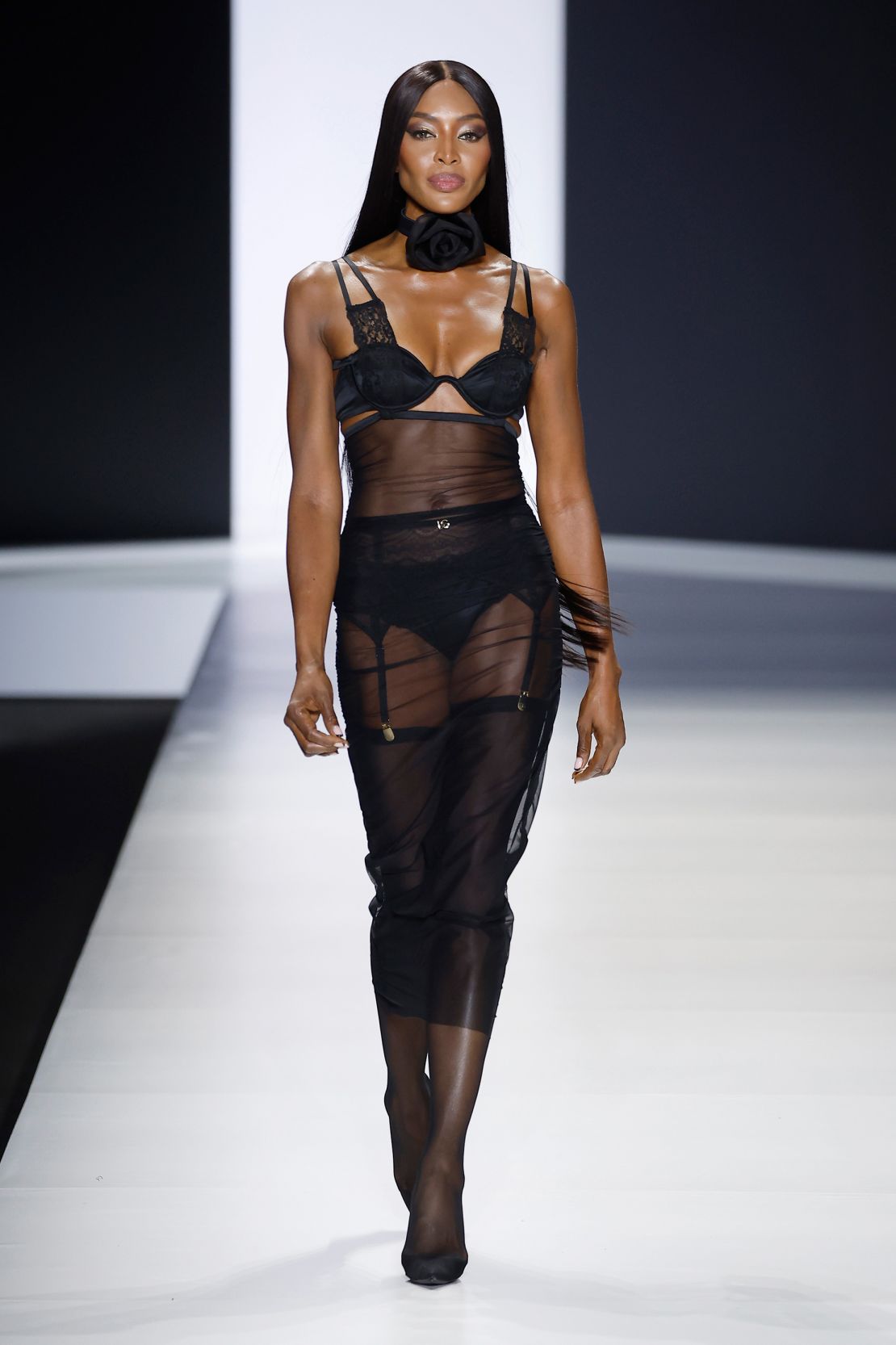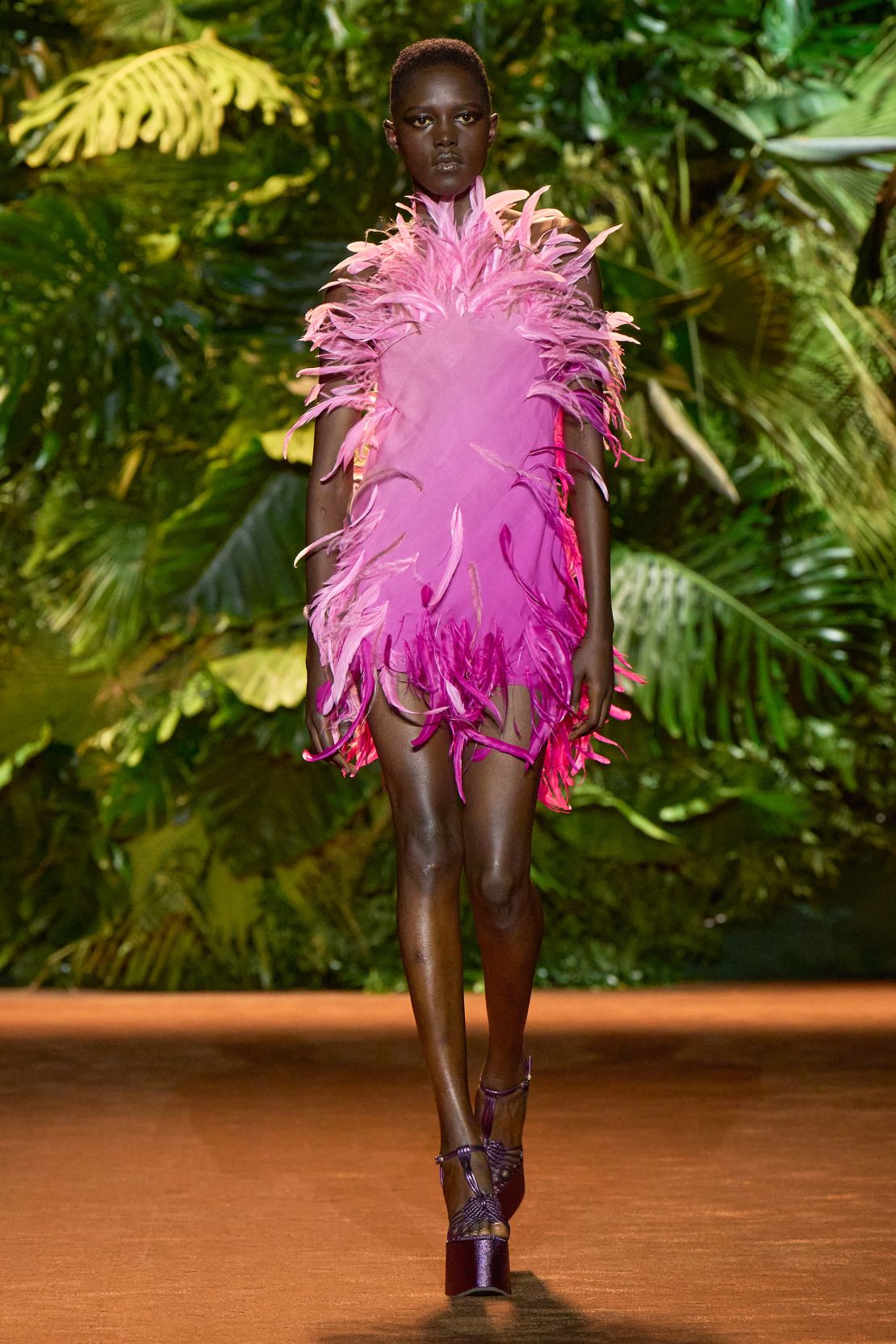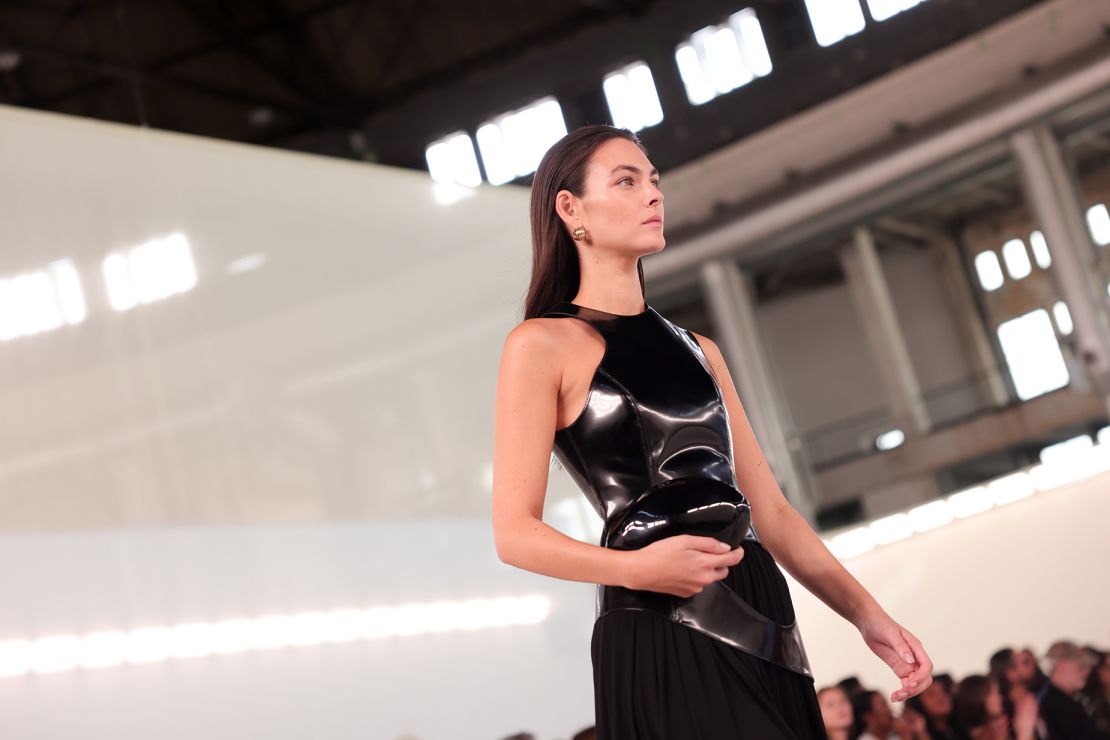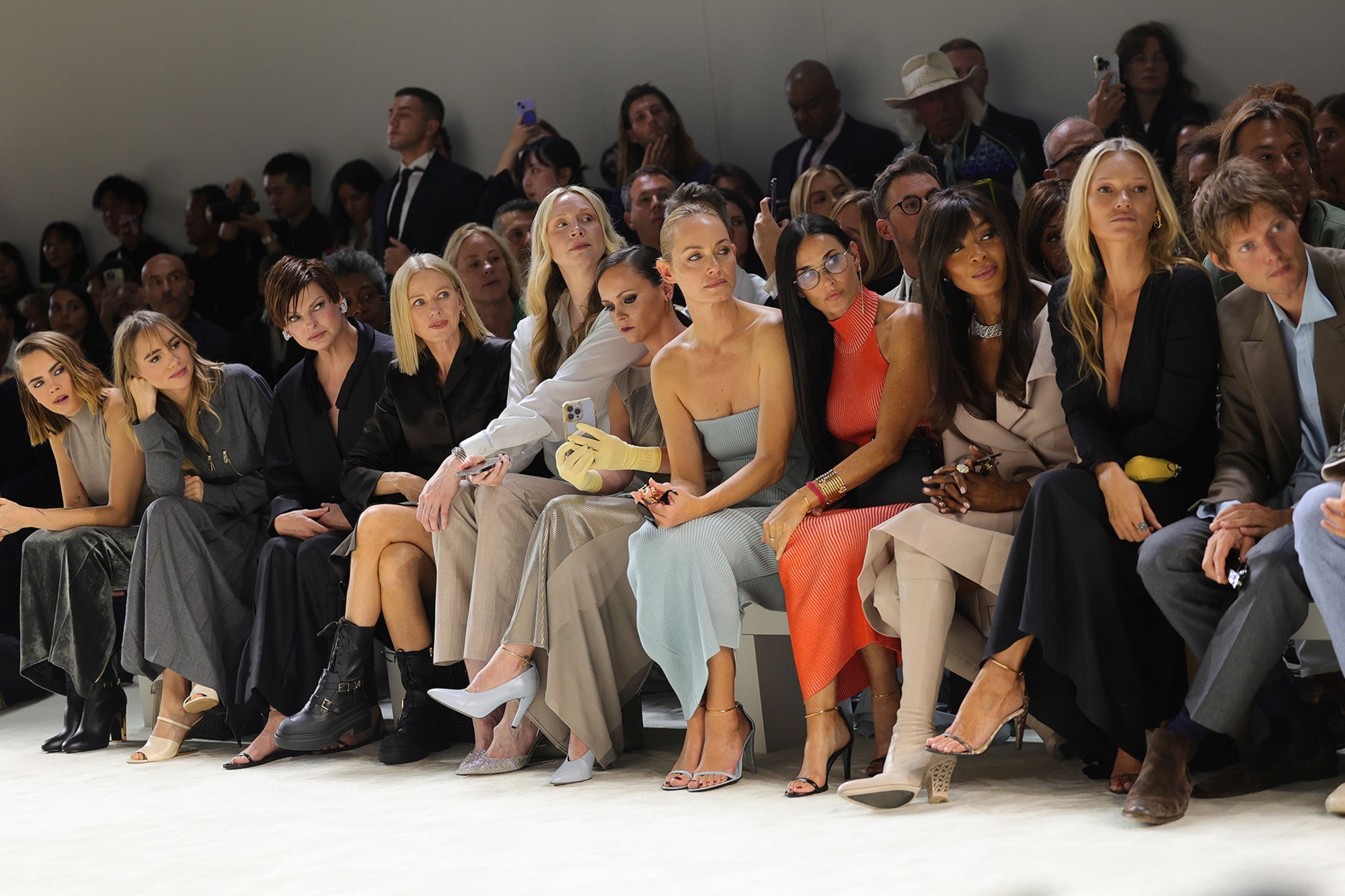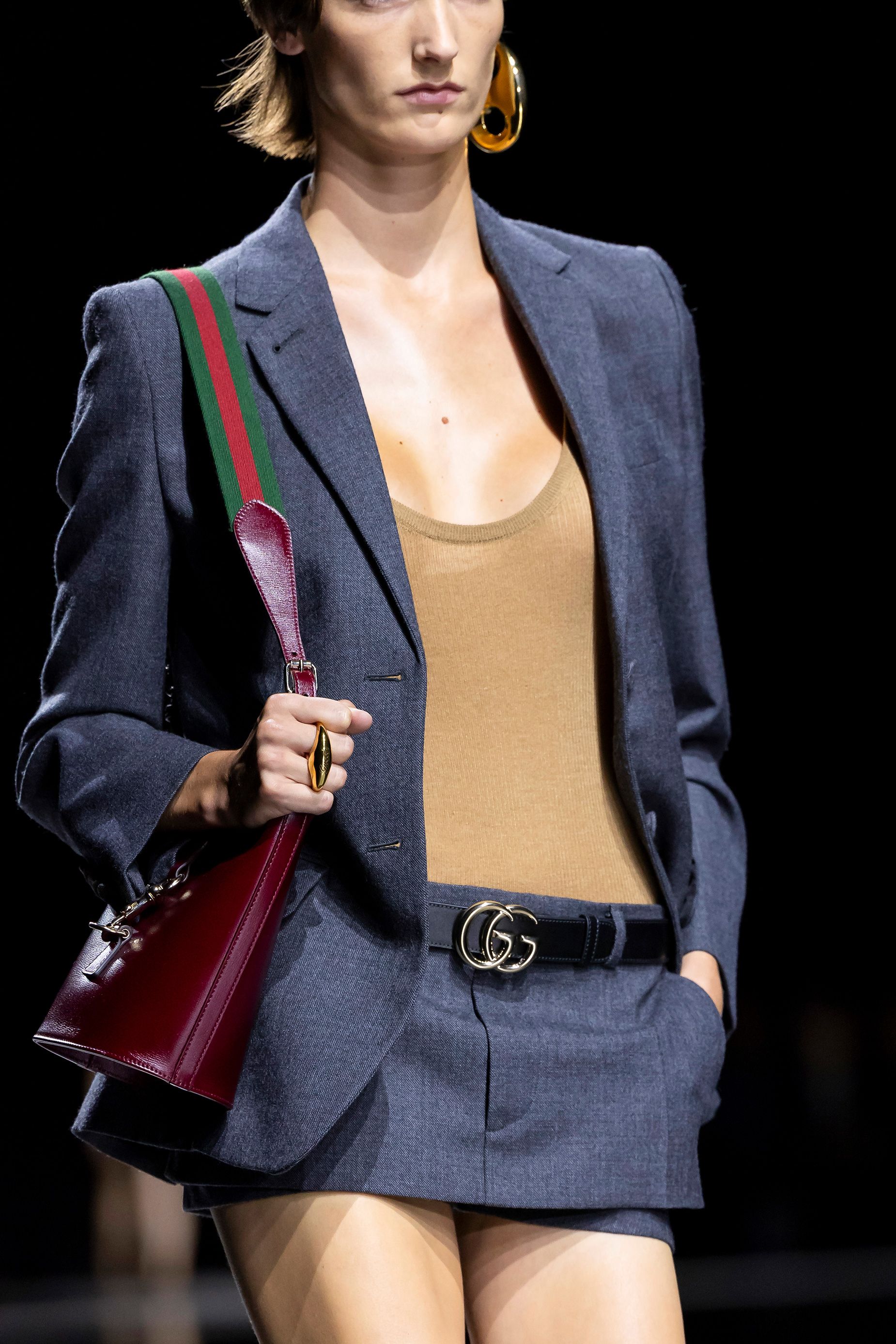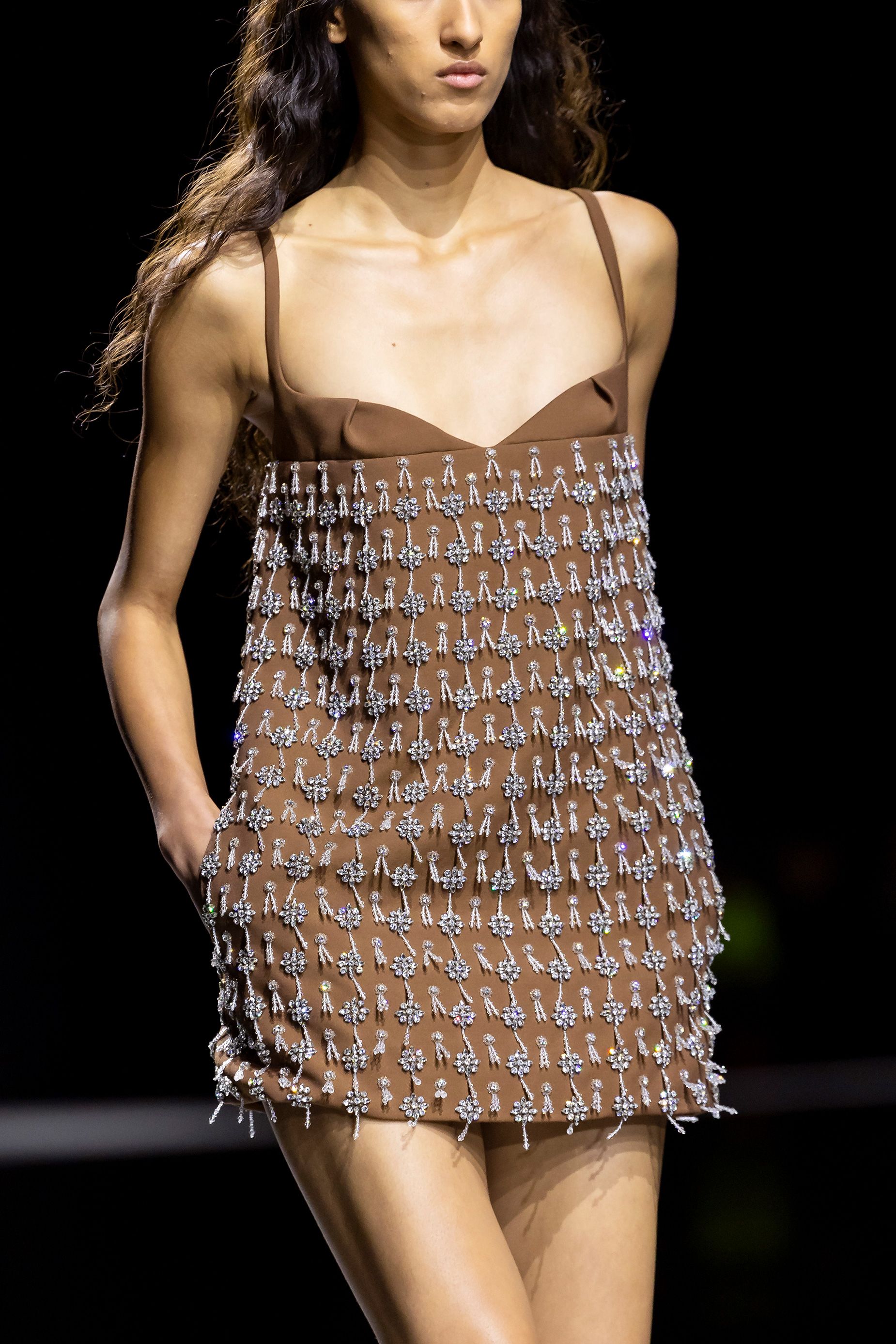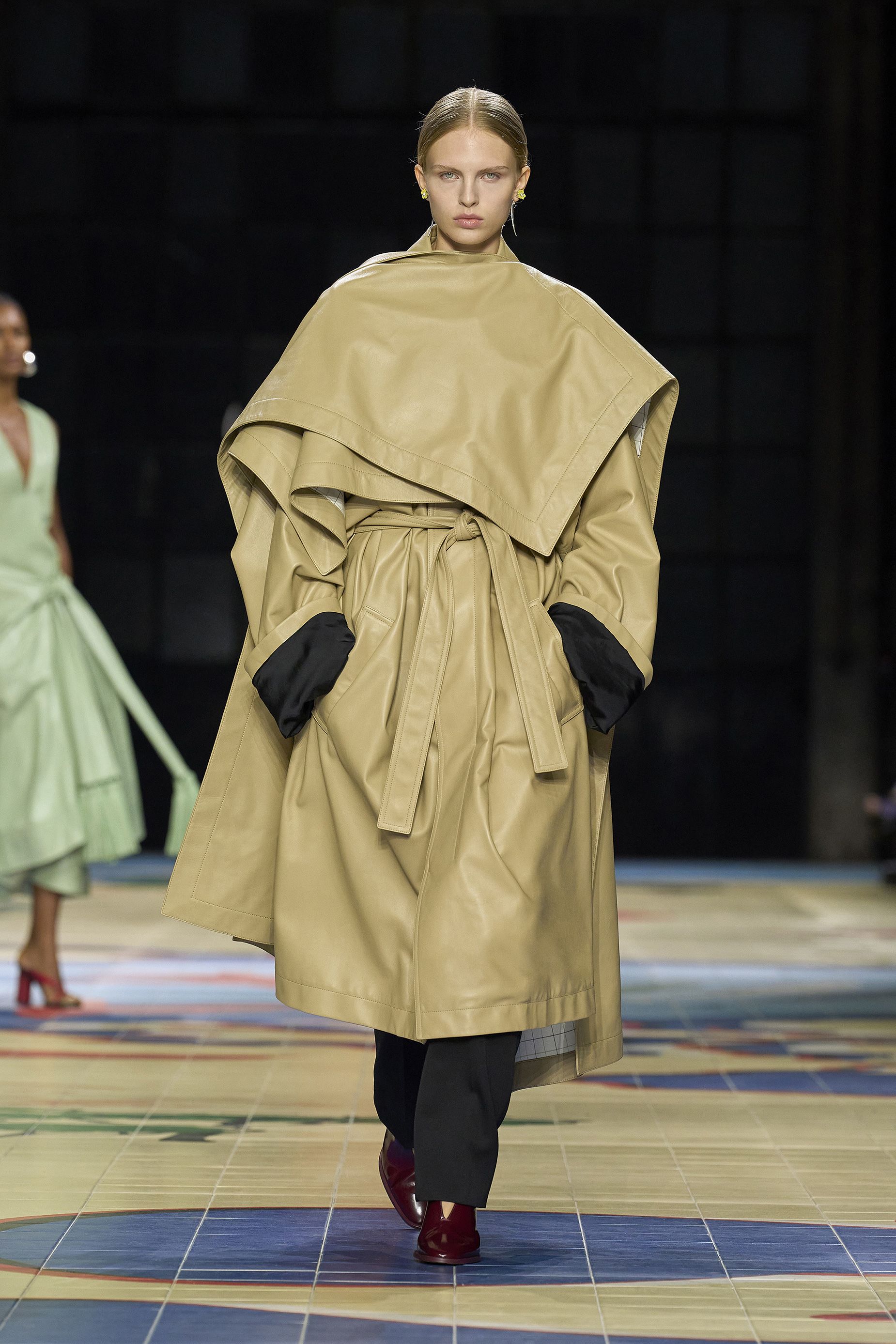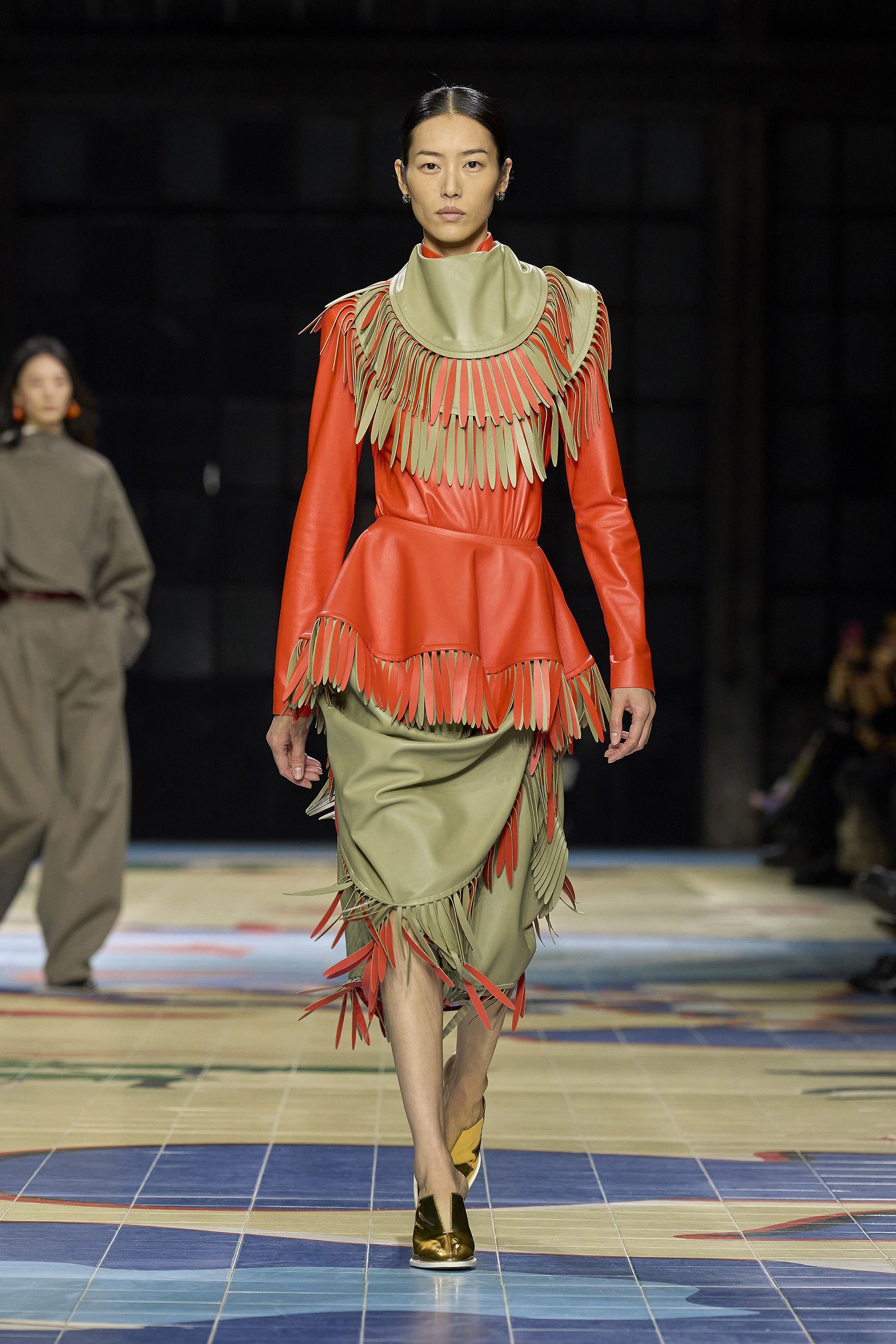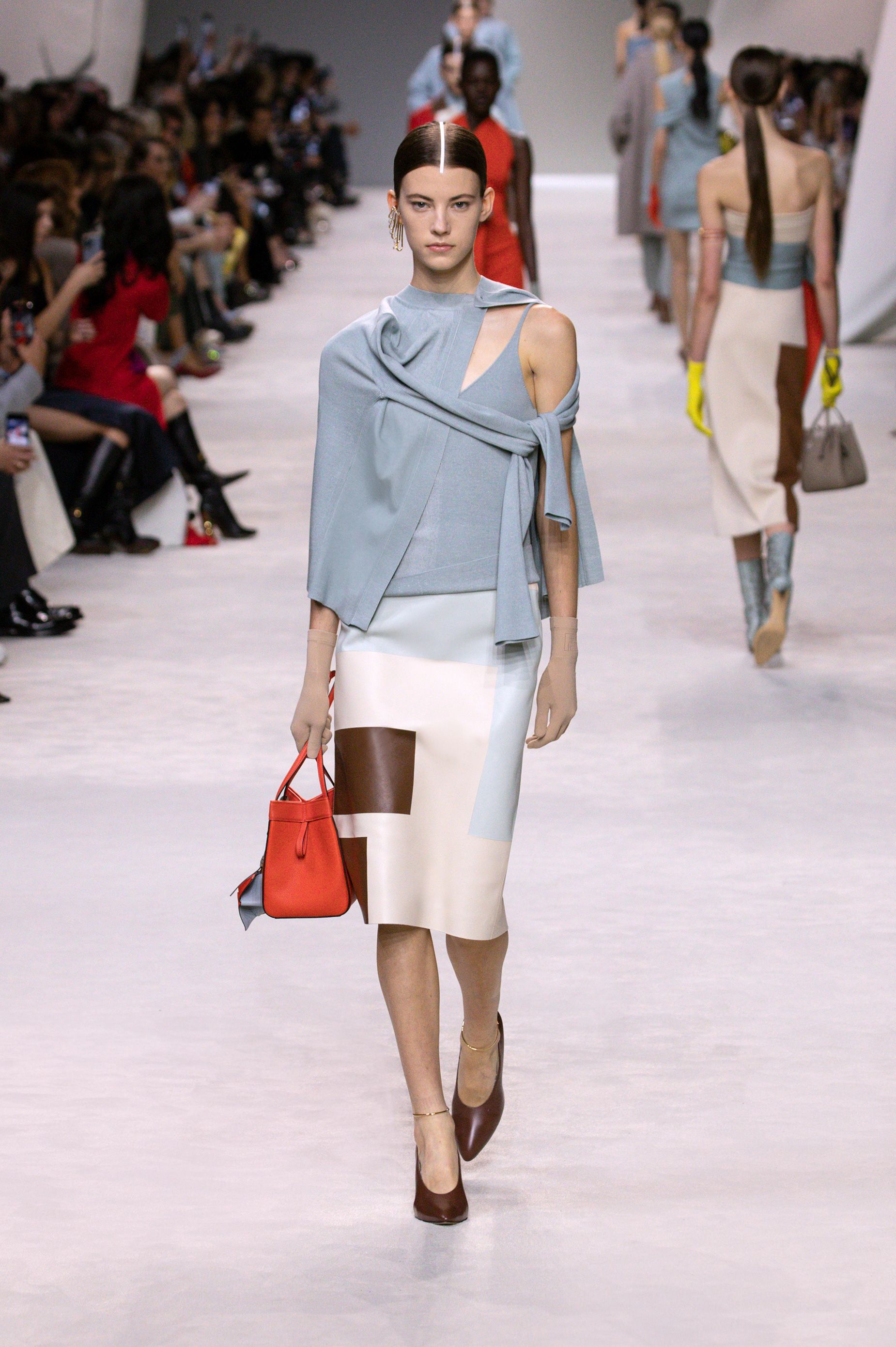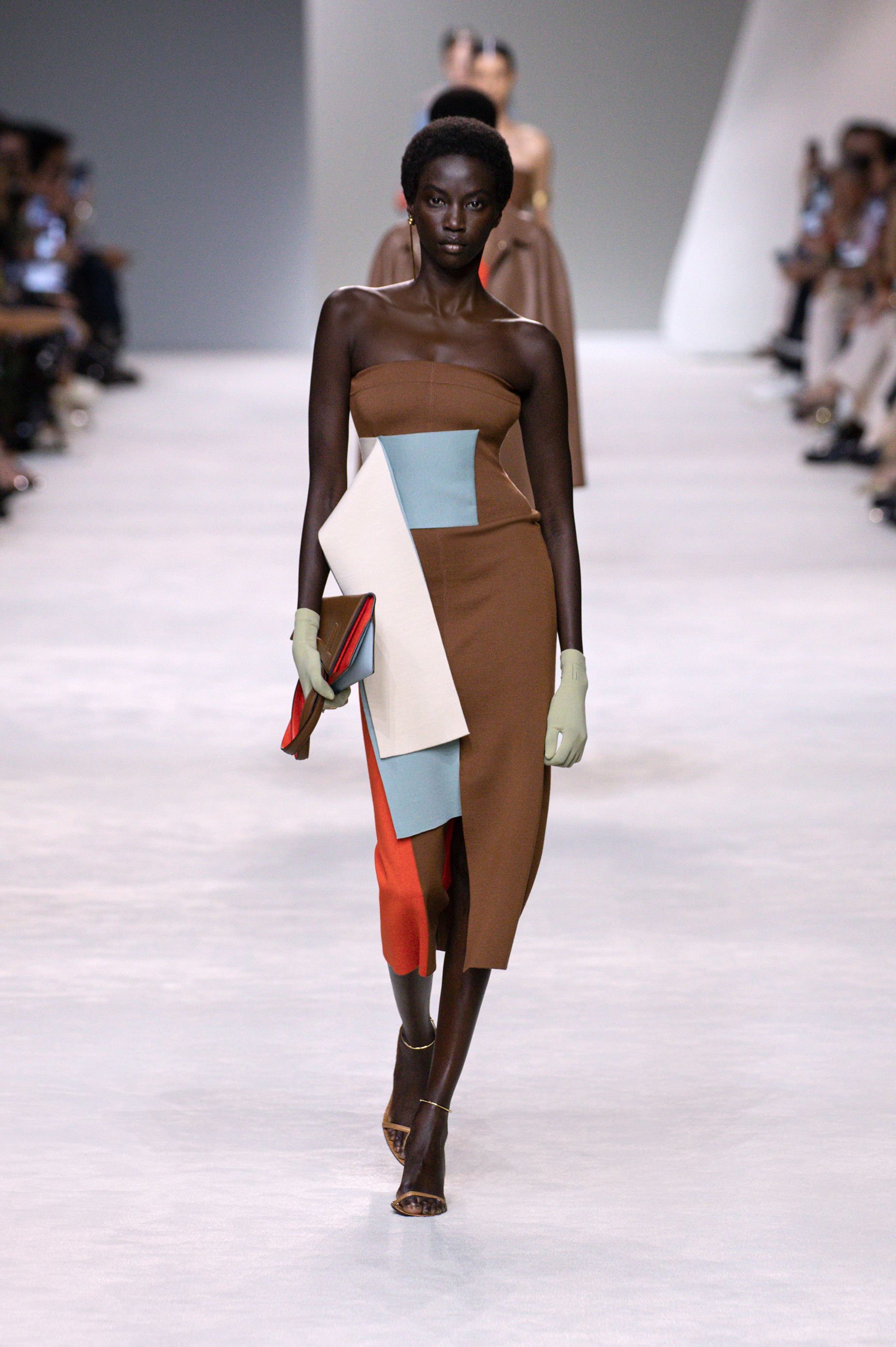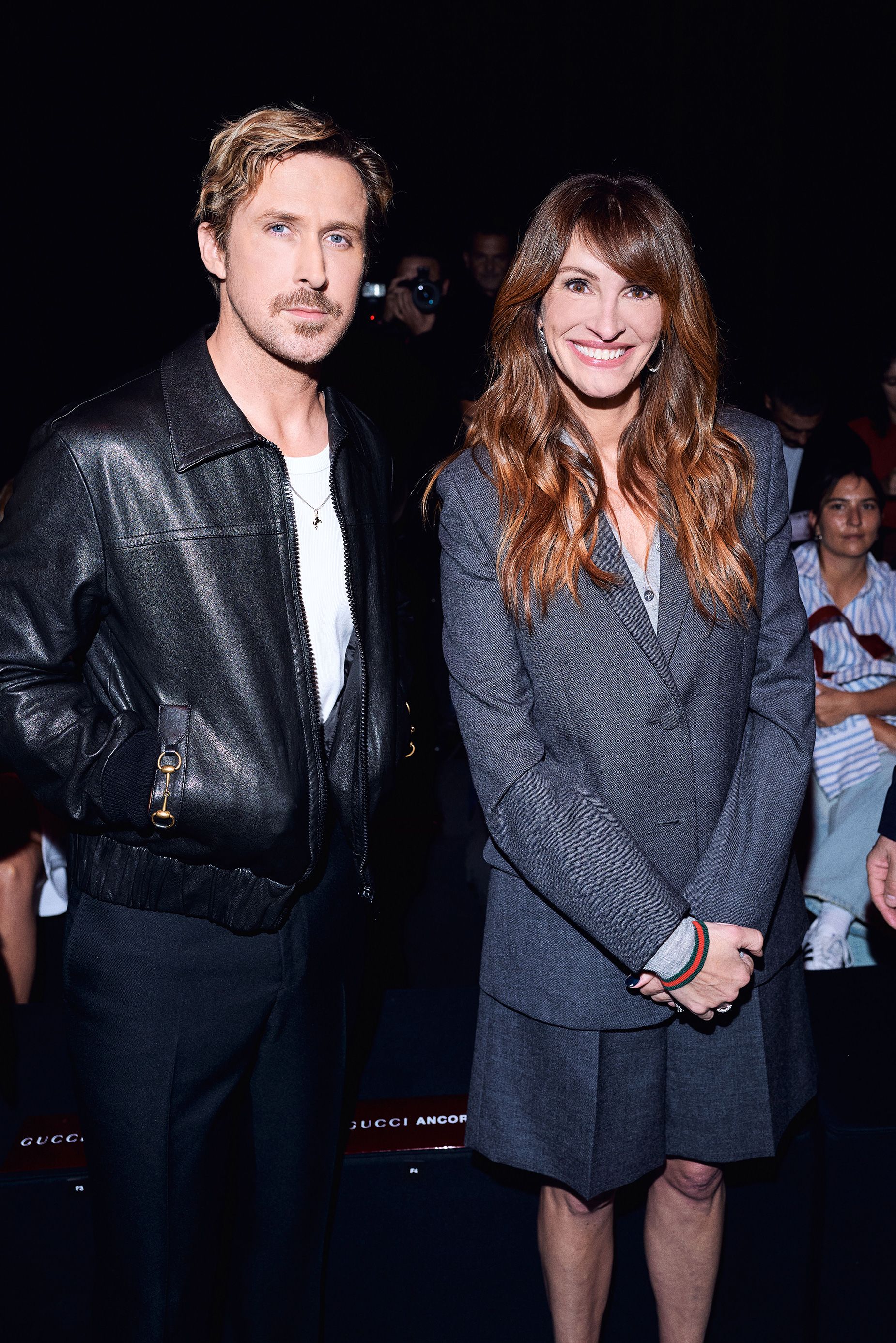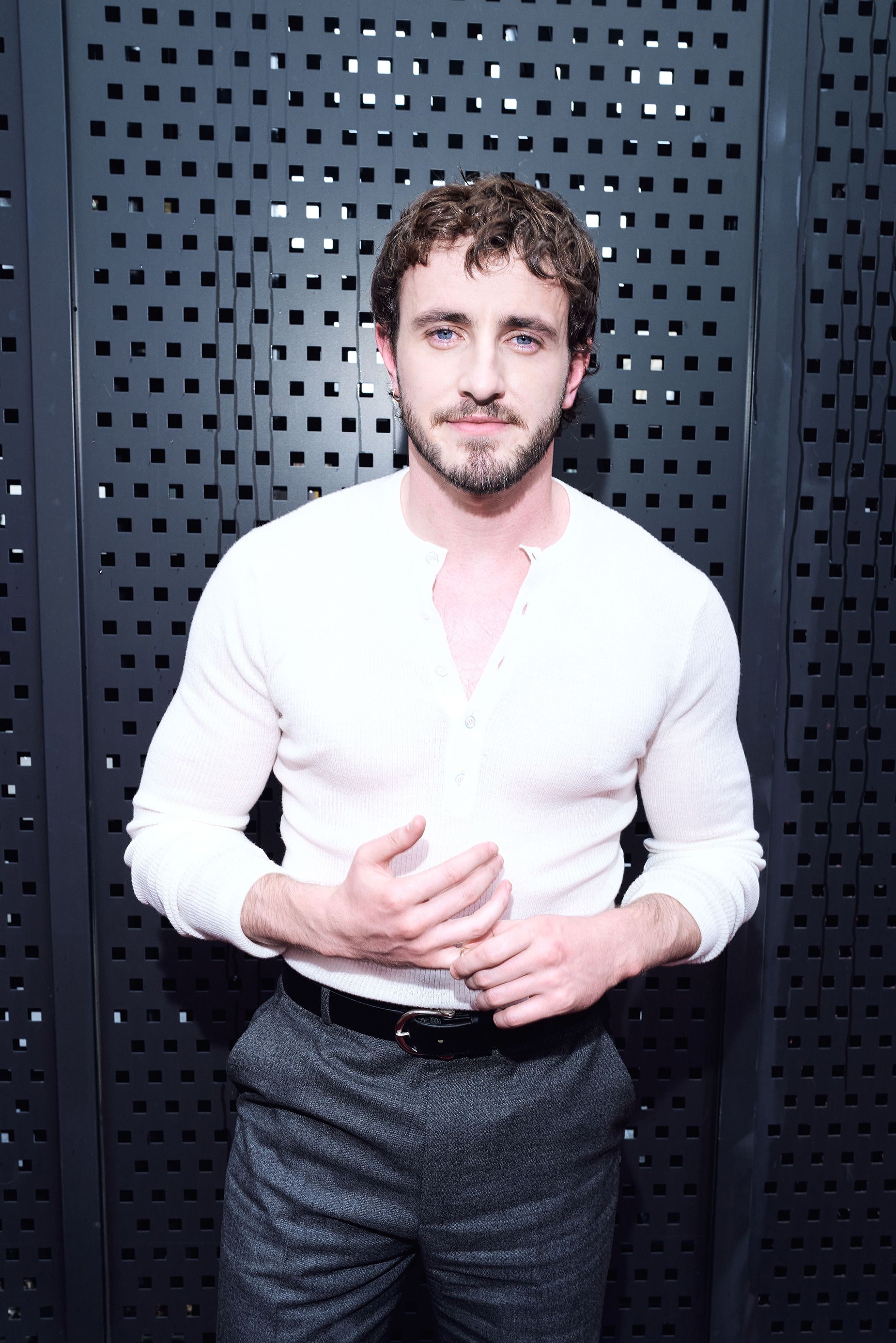Milan Fashion Week picked up where London left off last Wednesday, at least weather-wise. Just like in the last days of the British capital’s fashion bonanza, torrential rain with brief sunny spells marked much of the five-day event, bringing delays to many of the presentations and, in a few cases — most notably, the Gucci show — forcing organizers to move their venues.
But the downpours didn’t dampen the week’s mood, which was buzzy with expectation for several debuts, including Sabato de Sarno as new creative director of Gucci and Tom Ford’s first Milan show under British designer Peter Hawkings, Ford’s longtime protege. Both hit their strides with highly well received collections, as did a number of other familiar faces to Italy’s fashion capital. From Prada to Ferragamo, Fendi to Bottega Veneta, Milan proved once again that impeccable elegance is its watchword, and crisp femininity — which this season took the shape of knits, short shorts, red leather, and well-tailored jackets — its main aesthetic.

Not every brand shared that same vision — namely Diesel, the week’s enfant terrible, which, in pure Diesel style, put out a larger-than-life collection of distressed garments made of shredded deadstock jeans, recycled denim and vintage posters transformed into crumpled graphics, giving the audience true post-modern punk vibes in a rave setting, and the wildest presentation of the season.
Overall, however, the festivities showed a consistency of form that continues to make the Italian city Paris’s greatest rival to the fashion scene throne.
As per usual, movie stars and A-listers flocked to the proceedings, gracing front rows like it was their full-time job (given the strikes currently taking place in Hollywood, it might as well be). Gucci had the starriest attendance of them all, with Julia Roberts, Ryan Gosling, Gabrielle Union, Jessica Chastain, Paul Mescal, and Jodie Comer as just some of its VIP guests. Emma Watson, Scarlett Johansson, and Benedict Cumberbatch came out to support Prada, while Kate Moss, Linda Evangelista and Naomi Campbell sat together at Fendi. The list could go on.
Read on for our main Milanese takeaways.
Everything old is new again
Anna Wintour might once have said that fashion is not about looking back but looking forward (in the 2009 documentary “The September Issue”), but several brands in Milan turned to the past — and their archives — for their Spring-Summer 2024 collections.
Kim Jones did it first at Fendi, which opened the week with a line-up of streamlined, beautifully tailored clothes that took a cue from the label’s Spring-Summer 1999 collection, (designed by Karl Lagerfeld) — though the creative also cited the classical statues of Rome as inspiration.
Prada referenced the 1920s flapper girl with dropped-waist dresses featuring swaying lashings of fringe, then hinted at the ’40s and ’80s with a series of menswear silhouettes that spanned oversized barn coats, gray and navy suits, and romper shorts. There were also traces of the ’60s and ’90s, the best example being a sleeveless shift dress made from organza and gazar (a type of silk) that seemed to float behind the models as they walked down the runway.
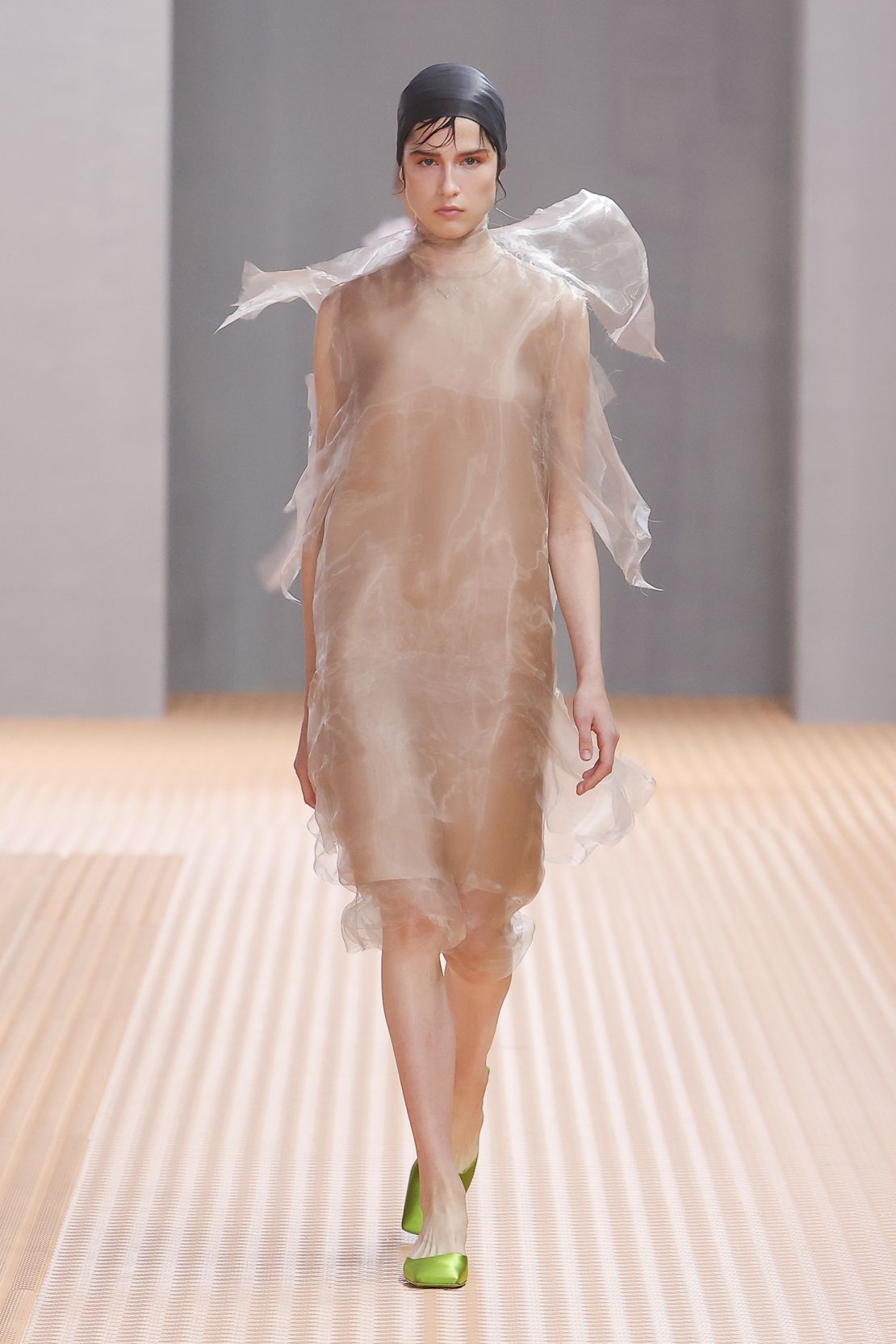
At Tom Ford, new designer Peter Hawkings paid homage to some of its predecessor’s greatest hits from the Gucci Spring-Summer 1996 show — skinny velvet suits, unbuttoned silk blouses and tiny shorts paired with towering stilettos — albeit with a slightly demurer approach.
Versace dipped into its Spring-Summer 1995 Atelier Versace archives to revisit its iconic hourglass jackets, checkerboard styles and sharp minidresses in georgette and jersey, and added a touch of 1960s-infused aesthetic with sorbet colors and silhouettes that could have easily been worn by Brigitte Bardot or Priscilla Presley back then.
More ‘90s nostalgia was seen at Tod’s and Philosophy di Lorenzo Serafini, while Max Mara designer Ian Griffiths drew from Britain’s Land Army (an all-female workforce created in 1939 to oversee the country’s farms while men were at war) to offer a series of utilitarian pieces that included apron-style dresses, boiler suits, jodhpur pants and parachute-strapped corsets.
The brand that took the crown for projecting the past into next season, however, was Moschino, currently in between designers. To mark its 40th anniversary, the house asked stylists Carlyne Cerf de Dudzeele, Katie Grand, Lucia Liu and Gabriella Karefa-Johnson to rethink some of Franco Moschino’s designs from 1983 to 1993 and create 10 looks each.
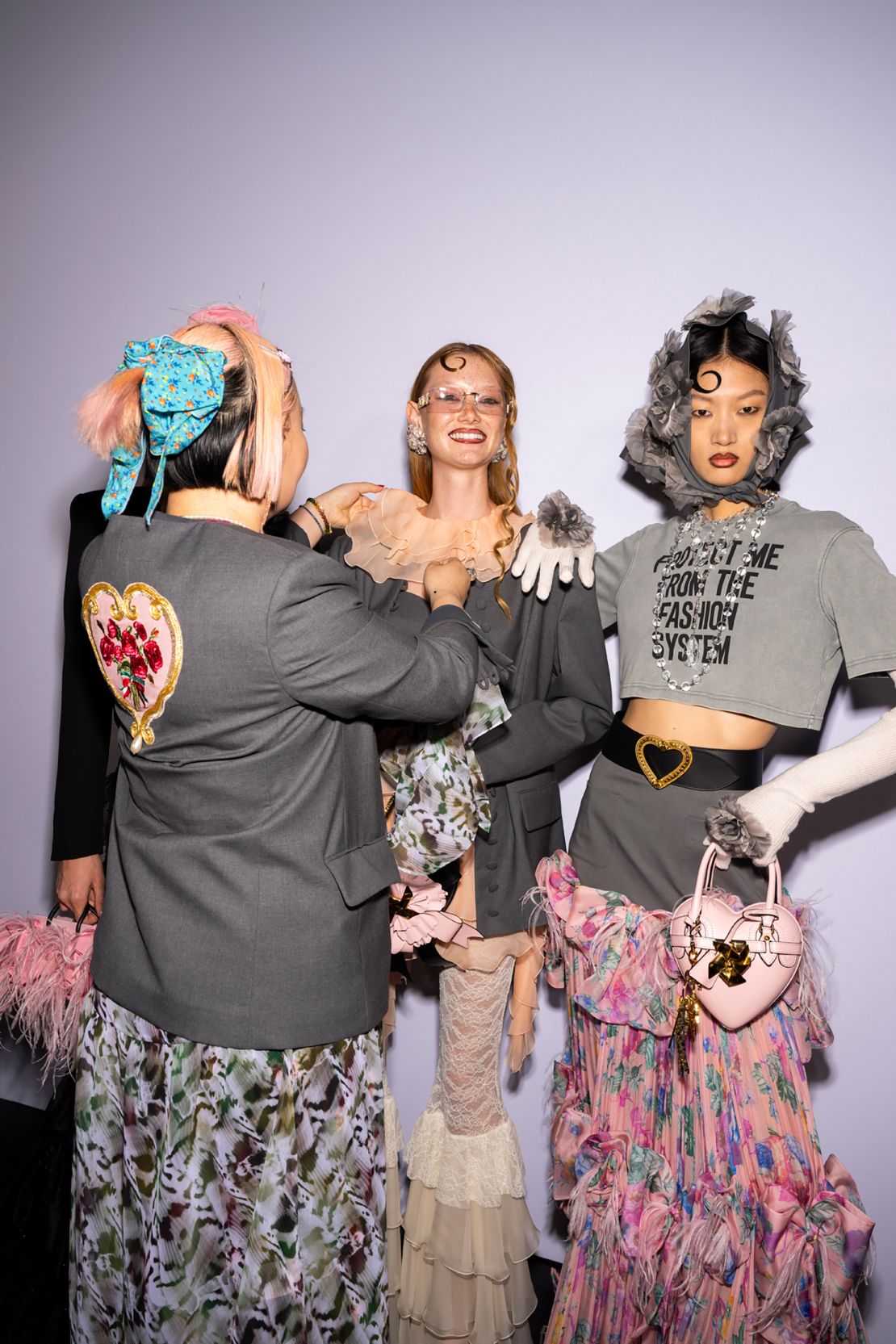
The resulting collection was a fun mix of styles, from Cerf de Dudzeele’s pared back silhouettes — a tribute to Moschino’s most timeless classics — to Karefa-Johnson’s statement jewelry and crochet dresses; Lucia Liu’s overly romantic and very fluffy gowns; and Grand’s “Loud Luxury” presentation, which featured black and white bodysuits painted with body parts and was modeled by elite dancers.
Comebacks and newcomers
Gucci and Tom Ford might have been the most-anticipated premieres of the season, but they were far from the only surprises.
After skipping last February’s fashion week to show in Los Angeles and, more recently, Cannes, Donatella Versace returned to Milan with a star-studded presentation that confirmed the brand’s clout when it comes to tapping into fashion’s — and pop culture’s — zeitgeist. Kendall Jenner, Gigi Hadid, Natalia Bryant and Precious Lee all hit the runway, while Claudia Schiffer closed the show — the first time the 53-year-old German model has walked a catwalk in five years.
Supermodel power struck at Dolce & Gabbana, too, where Naomi Campbell wore the final look, a sheer three-quarter slip over lingerie – lacy underwear as outerwear being the main theme of the show – and received an almost standing ovation from the crowd.
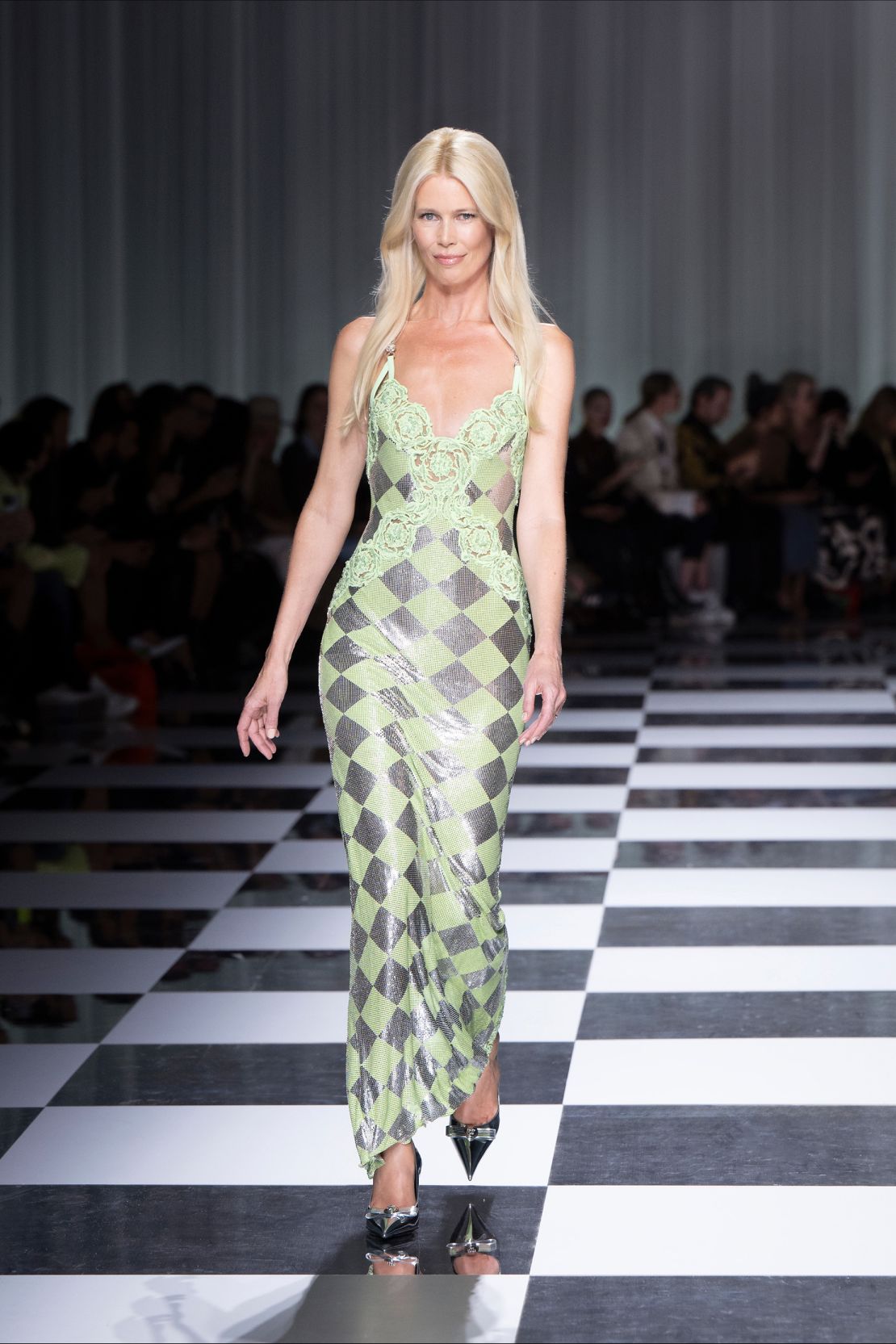
There were debuts at Bally, where new designer Simone Bellotti delighted with a well-constructed, feminine line-up that felt eminently wearable yet deeply bold and complex; and at once iconic brand Fiorucci with new creative director Francesca Murri, whose collection of fluid, intersectional looks hinted at a new chapter for the label.
Italian The Attico, which has built a near cult following since launching in 2016, also held their first runway show ever in Milan, to wide acclaim.
One of the most inspired comebacks though was that of Matthieu Blazy of Bottega Veneta. Though this was actually his fourth time showing for the fashion house, the Spring-Summer 2024 collection was a first of sorts, as it came after the closing of what Blazy has called the “Italian trilogy” — his tribute to Italy — from previous seasons.
For this new beginning, the French-Belgian designer took guests on an “odyssey,” picking up influences and inspiration from around the globe, which was abstractly reproduced on a tiled floor map with illustrations of flying fish, crabs and penguins. Models embodied travelers, each one with their own stories and places to go to — from the holiday-goer in a knit bathing to the office worker in a sharp coat and leather tie and the escapist, who donned woven dresses featuring giant raffia pom poms and fringed skirts with tufts of knit. The whole presentation was a lesson in range and craftsmanship, and a further glimpse into the visionary world of Blazy.
Cinematic sets and performative shows
Alongside the clothes, many brands made their sets a main talking point at fashion week.
Diesel, a veteran when it comes to mind-blowing scenography for its shows — remember last season’s giant mountain of condoms? — invited 7000 people (6000 of which were members of the public) to what was essentially an outdoor rave in a former railway yard, where it projected its runway on a giant screen under the rain.
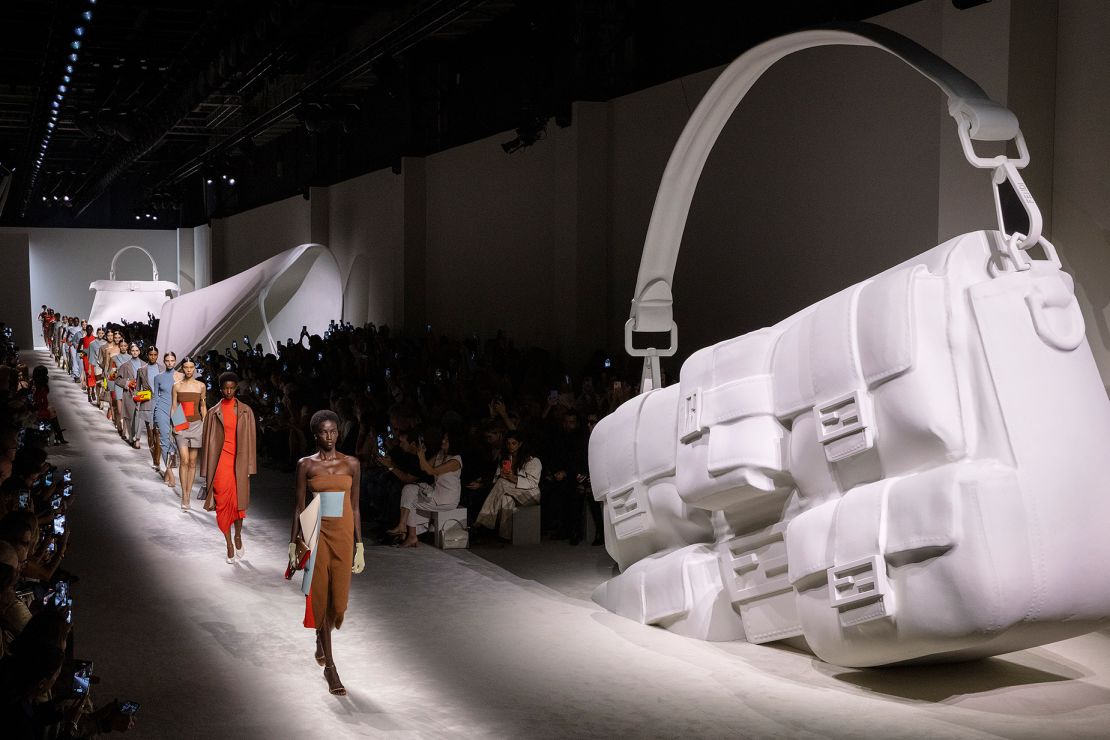
A few hours before, Cavalli staged a jungle-inspired presentation, welcoming guests to a scene of enormous hanging tropical plants and lush flowers, which matched the collection’s animal motifs and ‘70s hippie-rocker aesthetics.
Fendi went big on accessories, dotting its Milan showroom with 20 feet marble-effect sculptures of the house’s signature bags like the Baguette and the Peekaboo; and Prada opted for gossamer-like slime, which dripped thick and sticky from the ceiling of its Fondazione Prada venue to form liquid walls between the models.
At Missoni, large-scale silver spheres by artist Shawn Kolodny distorted proportions and highlighted the colors of the garments.
Some shows used Milan itself as main backdrop: The Attico closed off an entire residential street in western Milan and sat attendees (among which was Sabato de Sarno) on comfy leather sofas placed there for the occasion. Gucci, too, was initially supposed to host its show outside Accademia di Brera, Milan’s academy of fine arts, but was eventually forced to retreat to the brand’s headquarters due to heavy rain.
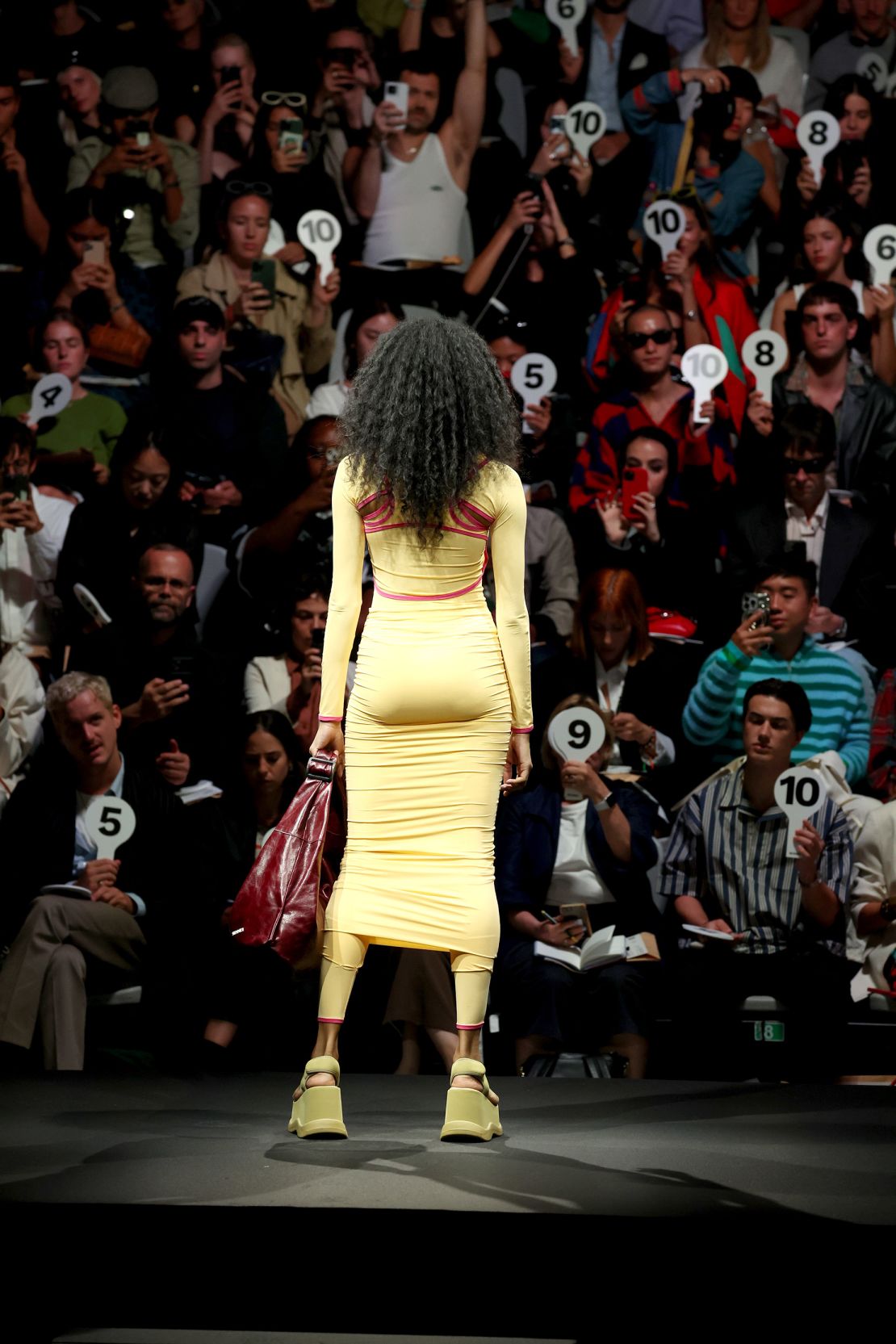
And then there were pure performances. At Sunnei, a brand known for its out-of-the-box, often interactive presentations, members of the audience were given 10 paddles with numbers from one to 10, to rate each look as it came out — a meta-commentary on the ephemerality of fashion in the social media age, where everyone’s a critic.
On Sunday, Stockholm-born designer Beate Karlsson of Avavav opted instead for a high-energy, highly-entertaining show that saw models frantically running back and forth with fake mascara-filled tears streaming down their faces, some half-dressed, some only wearing one shoe or backless shirts stating “Add back!?,” to take a stab at the fast-paced design processes of today’s fashion ecosystem and the impossible time crunches creatives are often in. The whole thing felt manic, tongue-in-cheek, and satirical — a good end to a packed week.
